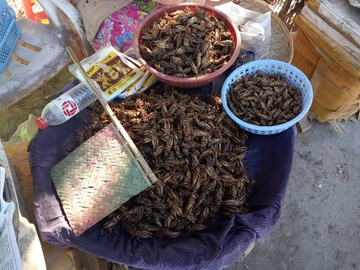The potential of edible insects in Madagascar and Myanmar: Researchers investigate and inform on options
May 06, 2020.
The potential of edible insects to provide an alternative source of protein and nutrition has only recently been recognized in the Global North. Legislation adopted by the European Union last year makes it now possible for processors, supermarkets and restaurants to offer insect-based products to customers. At the same time, the agricultural sector has developed huge interest in using insects for feed, reflected in ongoing application and screening processes.
In contrast, in Madagascar and Myanmar insects became an integral part of food cultures in the form of daily meals, emergency foods or expensive delicacies a long time ago. In these parts of the world, insects help overcome protein deficiencies in lean times and contribute to diversified diets. Whereas insects in Madagascar are cheaper than meat, in Myanmar insects are more expensive – and mostly collected in the wild and sold on the market to affluent urbanites. In both countries the collection of insects in the wild, either for household consumption or for sale, has put ecosystems and insect populations under stress. This stress is exacerbated by a rising demand from consumers for egg-bearing female insects (e.g. giant crickets or water beetles) because of their superior taste. The farmers, likewise, fetch a higher price for such females. One detected problem for consumers is that wild insects often accumulate pesticides in their bodies absorbed from agricultural production.
ProciNut researchers on the ground
Researchers from the ZEF-led ProciNut project, are attempting to establish functioning and safe insect production and processing systems by promoting insect rearing, providing training, and developing training materials for extension services in both Myanmar and Madagascar. In addition, the project group develops curricula for universities, value chains and organizes policy events. In Madagascar, trials were started on alternative feeds for the wild silk worm (Borocera cajani), on rearing local crickets (Gryllus madagascariensis), and on a locust species not classified as pest.
The non-governmental organization “New Generation Nutrition” from the Netherlands and the International Centre of Insect Physiology and Ecology (icipe) from Kenya have conducted training sessions on black soldier fly rearing and on cricket production in the central highlands of Madagascar. The participating farmers welcomed the training and will now try to establish their own small-scale production systems. In Myanmar, trials are currently being conducted on rearing house crickets (Acheta domesticus) at the Kengtung University and with farmers in the area. At Yezin Agricultural University, Myanmar, trials are running on the semi-domestication of giant crickets (Brachitrupes portentosus), which is the most consumed insect in the country. So far, it has been unsuitable for rearing because of its long life cycle (the shorter the life cycle of insects, the higher the viability). First trials on different processing techniques in both countries and on the production of insect powder for serving as local snacks or side dishes are underway.
From theory to practice: unexpected constraints
Research has so far revealed unexpected constraints. The first is the absence of insight by farmers and policy makers that insect rearing is feasible and has the potential to enhance livelihoods and serve as a source of nutrition. The second is the lack of markets. Most insect markets in Madagascar are highly localized, whereas in Myanmar country-wide value chains only exist for giant crickets, silk worms or bamboo borers (partly imported from Thailand and China). Compared with conventional livestock rearing, which has a long tradition and hundreds of years of breeding experience, insect rearing is a new field and still requires extensive baseline research. This is especially the case if one targets species beyond the dozen or so that are currently reared across the world. Even with regard to these better known species, issues such as ideal rearing conditions, productivity or food safety are yet to be sufficiently handled.
About the author
Sarah Nischalke is a senior researcher at ZEF and coordinator of the ProciNut project.
Contact: snischal[at]uni-bonn.de
This article was published in ZEFnews 40. For the full issue see:https://www.zef.de/fileadmin/user_upload/ZEFnews_no40.pdf
ZEF's Procinut research is financially supported by the German Federal Ministry of Food and Agriculture (BMEL) based upon a decision of the Parliament of the Federal Republic of Germany (Bundestag).



